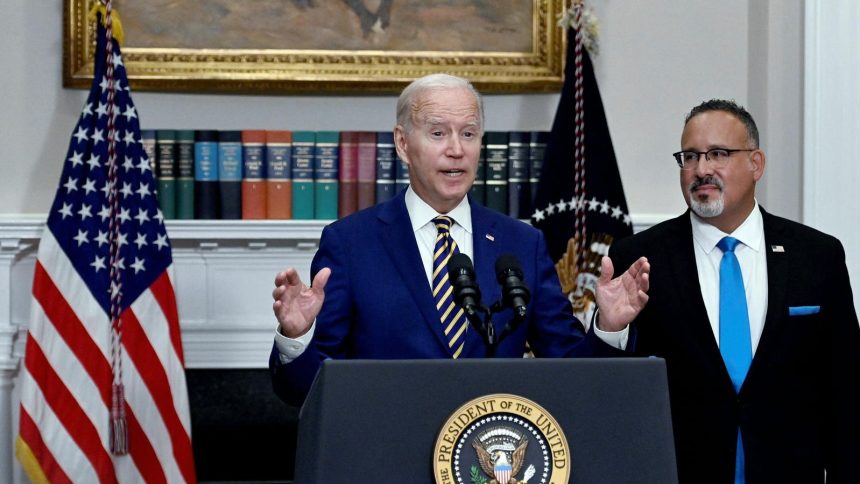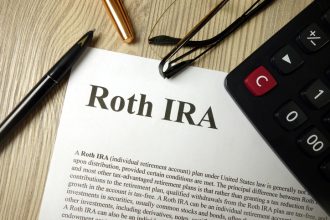The Education Department released formal regulations for President Joe Biden’s massive new student loan forgiveness plan this week. Millions of borrowers can potentially qualify. And unlike Biden’s first student debt relief initiative, many could see complete cancellation.
“If implemented as proposed, these plans, and others announced by the President, would bring the total number of borrowers getting relief under the Biden-Harris Administration to more than 30 million,” said the department in a statement released on Tuesday. The 30 million figure includes more than four million borrowers who have already been approved for student loan forgiveness under other Biden initiatives.
Biden’s new plan will provide multiple, distinct pathways to relief for borrowers depending on their loan history, the school they attended, and their overall personal and financial circumstances. Here’s a breakdown of who qualifies, how people would apply, and when relief could begin.
Student Loan Forgiveness For 25 Million Borrowers With Extreme Interest Accrual
A central feature of Biden’s new student loan forgiveness plan is automatic cancellation of excess interest.
“There are 25 million borrowers whose interest is growing faster than they can pay it down,” said Under Secretary of Education James Kvaal earlier this week. “That fact alone shows how badly President Biden’s student loan relief is needed.”
The draft regulations provide two paths to relief for borrowers who have experienced runaway interest accrual and capitalization:
- Borrowers could qualify for automatic student loan forgiveness of up to $20,000 if a “borrower’s loans currently exceed what they owed upon starting repayment” due to excess interest accrual or capitalization. All federal loan borrowers could qualify for this relief, including those who have consolidated their loans or are in default.
- Additional borrowers could get complete forgiveness of accrued or capitalized interest if the borrower is enrolled in an income-driven repayment plan (such as the new SAVE plan) and earns below income thresholds: $120,000 if they are single or married filing taxes separately, or $240,000 if married-filing-jointly.
“No application will be needed for borrowers to receive this relief if these plans are implemented as proposed,” said the department.
Cancellation Of Student Loans For 2.6 Million Borrowers Who Entered Repayment 20 or 25 Years Ago
Another proposed rule under Biden’s new plan would provide student loan forgiveness to borrowers who first entered repayment on their loans at least 20 years ago:
- Borrowers with only undergraduate, government-held federal loans who first entered repayment on or before July 1, 2005 could get complete student loan forgiveness.
- Those with any graduate student loans and FFEL-program loans who first entered repayment on or before July 1, 2000 could also get complete student loan forgiveness.
Most federal student loans, including consolidation loans and Parent PLUS loans, could qualify for this relief. The Education Department would authorize student loan forgiveness automatically, with no application required. Officials estimated that at least 2.6 million borrowers could qualify for cancellation under this rule.
Student Loan Forgiveness For Those Eligible For Relief Under Other Programs
The new draft regulations also propose cancelling student debt for borrowers who qualify for student loan forgiveness through other programs, but haven’t yet enrolled. This would include income-driven repayment plans, Public Service Loan Forgiveness, disability discharges, and others. Around 1.7 million borrowers could be eligible for debt relief under this rule just through the IDR provision alone.
Student loan forgiveness via this pathway could be automatic, but only for loans that would otherwise be eligible for the above programs. For instance, FFEL-program loans don’t qualify for student loan forgiveness through PSLF unless consolidated into a Direct loan, so those loans couldn’t qualify for that specific form of relief under the proposed new rule, either.
Eliminate Student Debt For Borrowers Who Went To ‘Low Value’ Institutions
Another set of rules under the new Biden program would cancel student debt for borrowers who had enrolled in institutions that were of low financial value. This includes:
- Schools that became formally excluded from federal financial aid programs due to high default rates, low graduation rates, or failure to meet gainful employment standards.
- Institutions that closed prior to agency action excluding them from federal financial aid programs but had similar deficits in their outcome metrics.
Student Loan Forgiveness For Personal And Financial Hardships
A final set of rules would authorize student loan forgiveness for borrowers experiencing some sort of personal or financial hardship.
The Education Department did not release formal draft regulations for this pathway to relief, but indicated that the final version of this rule would reflect the proposals that rule-makers agreed to earlier this year. Those rule-makers reached consensus on 17 possible “indicators” of hardship which include low income, high expenses, other debt obligations, demonstrated need through prior approval of other means-tested government programs, age, and disability status.
The Biden administration “remains hard at work on a separate proposal that would help many other borrowers experiencing hardship related to student loans that creates a barrier to them fully repaying their loans or the cost of collection is not justified,” said the department in its statement. “That rule will be released for comment in the coming months.”
Relief under this provision of the program would probably not be automatic. Borrowers will likely have to submit an application, which has not yet been developed or finalized. More information on the application process should be released in a few months.
Borrowers Could Get Relief Under Biden’s New Student Loan Forgiveness Plan By The Fall
With the final regulations published, the public now has an opportunity to submit comments. There will be a 30-day window during which the Education Department will receive public comments. After that, the program will be finalized and prepared for implementation. Officials anticipate that borrowers could start receiving student loan forgiveness by this fall.
“The U.S. Department of Education (Department) will carefully consider comments received and aims to finalize these rules in time to start delivering relief this fall,” said the department’s statement.
Most observers, however, widely expect that Biden’s new plan will be subject to legal challenges. Although the program is being established through a different legal authority than his first student debt relief plan, the courts may ultimately have the final say on whether borrowers will receive any loan forgiveness.
Read the full article here
















